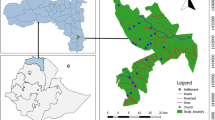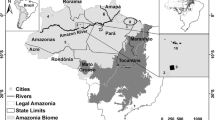Abstract
Concerns about rapid tropical deforestation, and its contribution to rising atmospheric concentrations of greenhouse gases, increase the importance of monitoring terrestrial carbon storage in changing landscapes. Emerging markets for carbon emission offsets may offer developing nations needed incentives for reforestation, rehabilitation, and avoided deforestation. However, relatively little empirical data exists regarding carbon storage in African tropical forests, particularly for those in arid or semi-arid regions. Kenya’s 416 km2 Arabuko-Sokoke Forest (ASF) is the largest remaining fragment of East African coastal dry forest and is considered a global biodiversity hotspot (Myers et al. 2000), but has been significantly altered by past commercial logging and ongoing extraction. Forest carbon storage for ASF was estimated using allometric equations for tree biomass, destructive techniques for litter and herbaceous vegetation biomass, and spectroscopy for soils. Satellite imagery was used to assess land cover changes from 1992 to 2004. Forest and thicket types (Cynometra webberi dominated, Brachystegia spiciformis dominated, and mixed species forest) had carbon densities ranging from 58 to 94 Mg C/ha. The ASF area supported a 2.8–3.0 Tg C carbon stock. Although total forested area in ASF did not change over the analyzed time period, ongoing disturbances, quantified by the basal area of cut tree stumps per sample plot, correlated with decreased carbon densities. Madunguni Forest, an adjoining forest patch, lost 86% of its forest cover and at least 76% of its terrestrial carbon stock in the time period. Improved management of wood harvesting in ASF and rehabilitation of Madunguni Forest could substantially increase terrestrial carbon sequestration in the region.
Similar content being viewed by others
References
ASFMT: Arabuko-Sokoke Forest Management Team (February, 2002) Arabuko-Sokoke strategic forest management plan, 2002–2027. Paper presented at the Gede Forest Station, Kenya with financial support from European Union, Tropical Forest budget line, Contract B7-5041/95-07/VII.
Brower, J. E., Zar, J. H., & von Ende, C. N. (1997). Field & laboratory methods for general ecology (4th ed.) Dubuque, Iowa: William C. Brown.
Brown, S. (1997). Estimating biomass and biomass change of tropical forest: A primer. Rome: Food and Agriculture Association of the United Nations, FAO.
Brown, S., & Gaston, G. (1995). Use of forest inventories and geographic information systems to estimate biomass density of tropical forests: Application to tropical Africa. Environmental Monitoring and Assessment, 38, 157–168.
Brown, I. F., Martinelli, L. A., Thomas, W. W., Moreira, M. Z., Cid Ferreira, C. A., & Victoria, R. A. (1995). Uncertainty in the biomass of Amazonian forests: An example from Rondônia, Brazil. Forest Ecology and Management, 75(1–3), 175–189.
N. D. Burgess & G. P. Clarke (Eds.) (2000). Coastal forests of Eastern Africa. Switzerland: International Union for Conservation of Nature and Natural Resources, IUCN.
Cairns, M. A., Brown, S., Helmer, E. H., & Baumgardner, G. A. (1997). Root biomass allocation in the world’s upland forests. Oecologia, 111, 1–11.
Chave, J., Condit, R., Lao, S., Caspersen, J. P., Foster, R. B., & Hubbell, S. P. (2003). Spatial and temporal variation of biomass in a tropical forest: Results from a large census plot in Panama. Journal of Ecology, 91(2), 240–252.
Clark, D. A., & Clark, D. B. (1999). Assessing the growth of tropical rain forest trees: Issues for forest modeling and management. Ecological Applications, 9(3), 981–997.
Fanshawe, J. H. (1995). The effects of selective logging on the bird community of Arabuko Sokoke Forest, Kenya. Dissertation, University of Oxford, UK.
FAO: Food and Agricultural Organization (1999). State of the world’s forests. Rome: United Nations Food and Agricultural Organization, FAO.
Harmon, M. E., & Sexton, J. (1996). Guidelines for measurements of woody detritus in forest ecosystems. US LTER Publication No. 20. Seattle, USA: US LTER Network Office, University of Washington.
Houghton, J. (1997). Global warming: The complete briefing (2nd ed.). Cambridge: Cambridge University Press.
Jaramillo, V. J., Kauffman, J. B., Rentería-Rodríguez, L., Cummings, D. L., & Ellingson, L. J. (2003). Biomass, carbon, and nitrogen pools in Mexican tropical dry forest landscapes. Ecosystems, 6, 609–629.
Kelsey, M., & Langton, T. (1984). The conservation of the Arabuko Sokoke Forest, Kenya. International Council for Bird Preservation (ICBP) Study Report #4. Cambridge, UK: University of East Anglia.
Lambert, J. D. H., Arnason, J. T., & Gale, J. L. (1980). Leaf-litter and changing nutrient levels in a seasonally dry tropical hardwood forest, Belize, C.A. Plant and Soil, 55, 429–443.
MacDicken, K. G. (1997). A guide to monitoring carbon storage in forestry and agroforestry projects. Washington, DC: Winrock Institute for Agricultural Development.
Martinez-Yrizar, A., Sarukhan, J., Perez-Jimenez, A., Rincon, E., Maass, J. M., Solis-Magallanes, A., et al. (1992). Above-ground phytomass of a tropical deciduous forest on the coast of Jalisco, Mexico. Journal of Tropical Ecology, 8, 87–96.
Mbuvi, M. T. E., Mathenge, J. M., Dida Forest Adjacent Area Forest Association, & ASFMT (2004). Discussion draft: Operational forest management plan for Dida PFM pilot zone. Paper submitted to the ASFMT, Gede Forest Station, Kenya.
Mchua, J., & Lelon, J. (2004). A study on soil characterization and nutrient flow analysis at farm and catchment level in Ganda, Goshi, and Jilore Locations (Malindi District). Unpublished report submitted to the Kenya Forestry Research Institute (KEFRI), Farm Forestry and National Resource Conservation Project (B7-6201/2000-02).
Mooney, H. A., Bullock, S. H., & Medina, E. (1995). Introduction. In S. H. Bullock, H. A. Mooney, & E. Medina (Eds.), Seasonally dry tropical forests (pp. 1–8). Cambridge, UK: Cambridge University Press.
Muchiri, M. N., Kiriinya, C. K., & Mbithi, D. M. (2001). Forest inventory report for the indigenous forests in Arabuko Sokoke Forest Reserve. Paper submitted to KEFRI, Nairobi, Kenya.
Murphy, P. G., & Lugo, A. E. (1995). Dry forests of Central America and the Caribbean Islands. In S. H. Bullock, H. A. Mooney, & E. Medina (Eds.), Seasonally dry tropical forests (pp. 1–8). Cambridge, UK: Cambridge University Press.
Mutangah, J. G., & Mwaura, P. K. (1992) Kenya indigenous forest conservation project (KIFCON) biodiversity surveys: Arabuko-Sokoke forest vegetation survey report. Paper submitted to KIFCON & National Museums of Kenya Centre for Biodiversity, Nairobi, Kenya.
Myers, N., Mittermeier, R. A., Mittermeier, C. G., da Fonseca, G. A. B., & Kent, J. (2000). Biodiversity hotspots for conservation priorities. Nature, 403, 853–858.
Ngala, D. (2004). Report on survey on forest destruction at Marafa Division as a result of human utilization. Paper submitted to Gede Forest Station, Kenya.
Pearson, T. R. H., Brown, S., & Ravindranath, N. H. (2005). Integrating carbon benefit estimates into GEF projects. New York, NY: United Nations Development Programme Global Environment Facility. http://www.winrock.org/ecosystems/files/GEF_Guidebook.pdf.
Robertson, S. A., & Luke, W. R. Q. (1993). Kenya coastal forests, the report of the NMK/WWF coast forest survey. Paper submitted to WWF project 3256: Kenya, Coast Forest Status, Conservation and Management, WWF & National Museums of Kenya Centre for Biodiversity, Nairobi, Kenya.
Shepherd, K. D., Palm, C. A., Gachengo, C. N., & Vanlauwe, B. (2003). Rapid characterization of organic resource quality for soil and livestock management in tropical agroecosystems using near-infrared spectroscopy. Agronomy Journal, 95, 1314–1322.
Shepherd, K. D., Walsh, M. G., & ICRAF (2002). Development of reflectance spectral libraries for characterization of soil properties. Soil Science Society of America Journal, 66(3), 988–998.
Woomer, P. (1993). The impact of cultivation on carbon fluxes in woody savannas of Southern Africa. Water, Air, and Soil Pollution, 70, 403–412.
Wright, H. L. (1999). Arabuko-Sokoke forest management and conservation project: Consultancy report on forest resource inventory and management. Paper submitted to Gede Forest Station, Kenya and European Commission, DGVIII, Contract B7-5041/95.07/VIII, Oxford Forestry Institute.
Zhang, Q., & Justice, C. O. (2001). Carbon emissions and sequestration potential of central African ecosystems. Ambio, 30(6), 351–355.
Author information
Authors and Affiliations
Corresponding author
Rights and permissions
About this article
Cite this article
Glenday, J. Carbon storage and emissions offset potential in an African dry forest, the Arabuko-Sokoke Forest, Kenya. Environ Monit Assess 142, 85–95 (2008). https://doi.org/10.1007/s10661-007-9910-0
Received:
Accepted:
Published:
Issue Date:
DOI: https://doi.org/10.1007/s10661-007-9910-0




